Abstract
Lever pressing by rhesus monkeys was maintained by morphine injections during four equally spaced sessions each day. During other periods, lever pressing was maintained by timeout from a continuous naloxone infusion (escape), or by timeout from a stimulus that preceded naloxone injections, or termination of the injections (avoidance-escape). As naloxone dose increased in the escape procedure, response rate increased to a maximum and then decreased. In the avoidance-escape procedure, response rate generally increased as naloxone dose increased, but the changes in rate were small compared to the excape procedure. Substitution of saline for naloxone in the escape procedure led to a very low response rates within three sessions. In the avoidance-escape procedure, rate decrements produced by saline substitution appeared to be related to the behavioral history of the monkey. Previous escape experience led to more rapid decreases in responding when saline was introduced, whereas responding was maintained for 15 sessions in a monkey without prior escape conditioning. Morphine pretreatment produced comparable, dose-dependent decreases in response rates in both procedures. The rate-decreasing effects of morphine were exacerbated when no naloxone was delivered in the escape procedure.
Full text
PDF
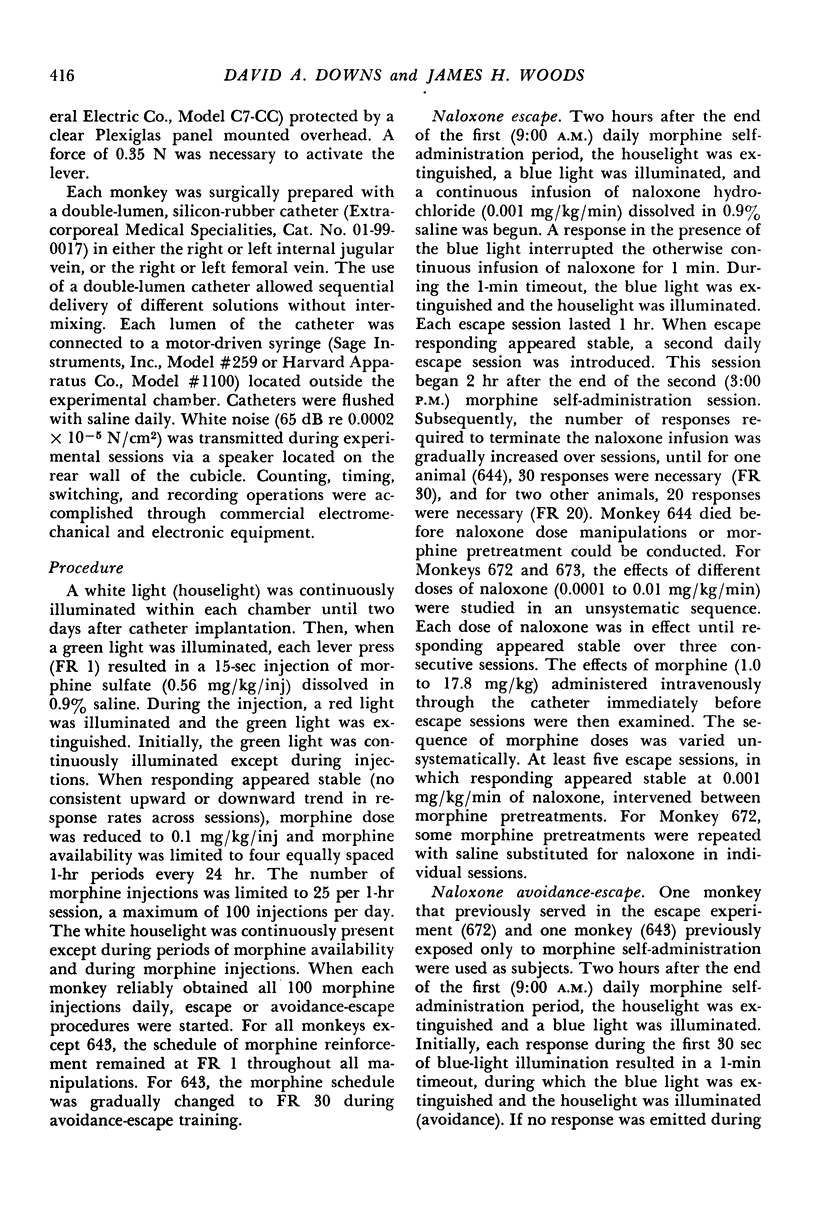


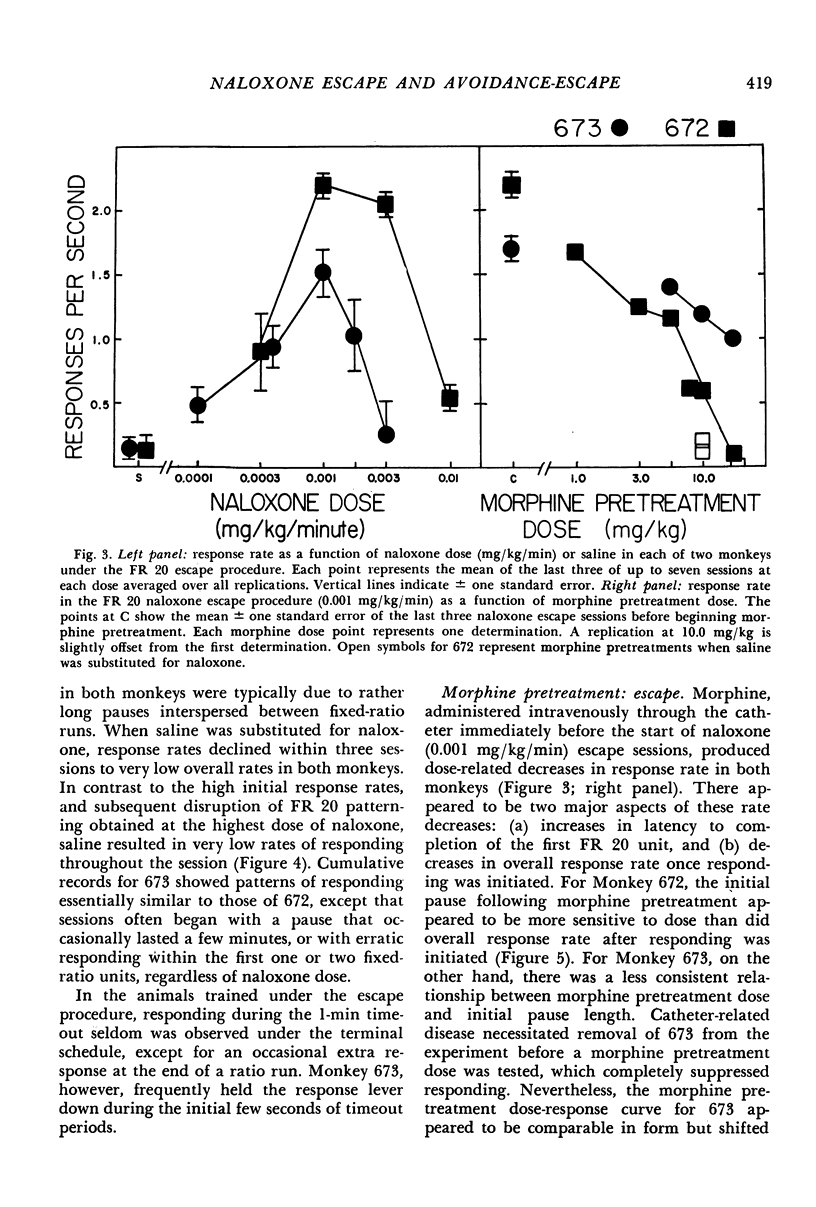

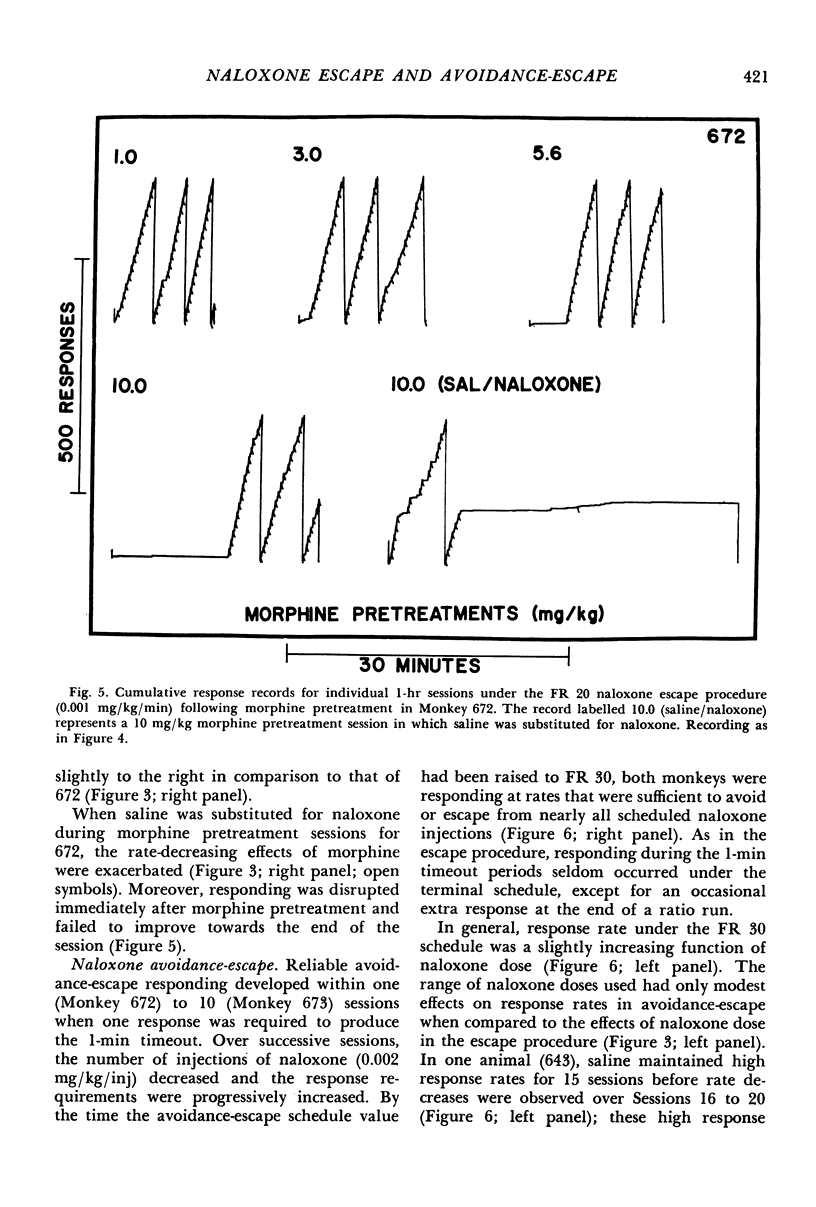

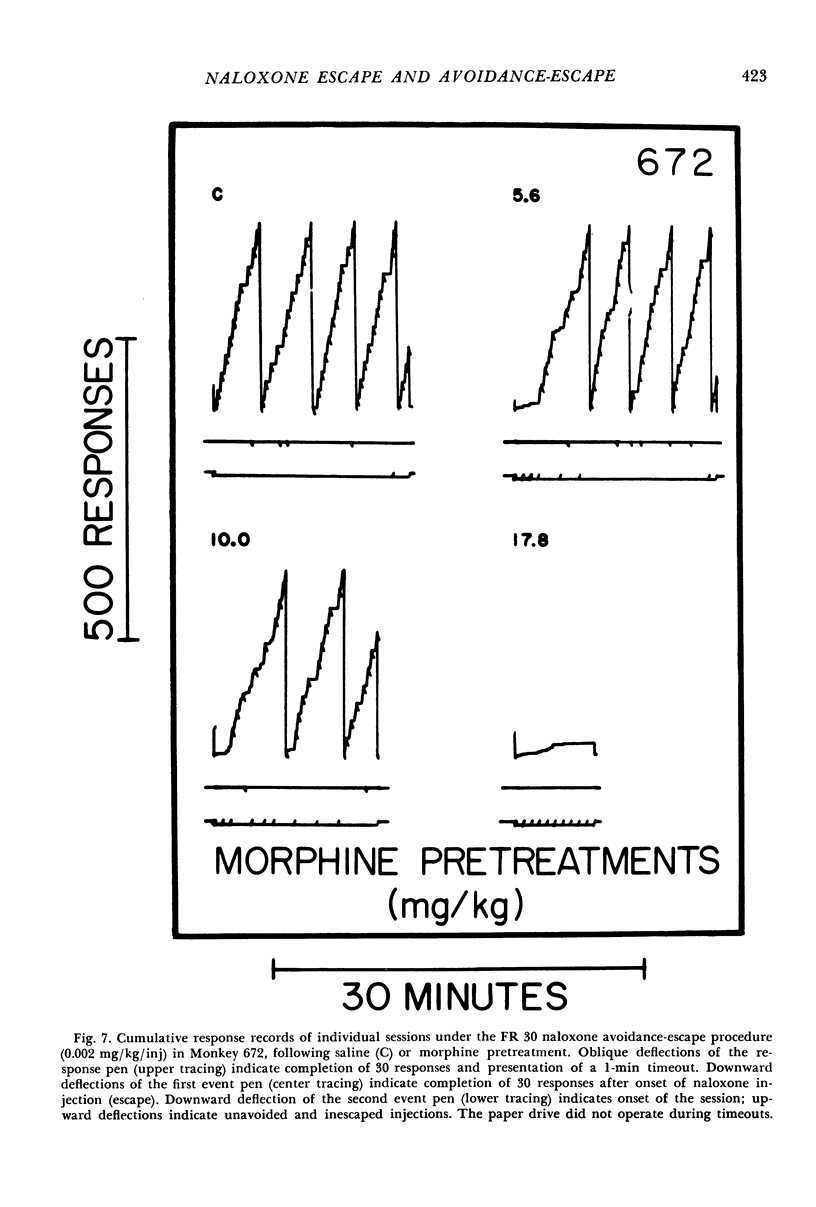
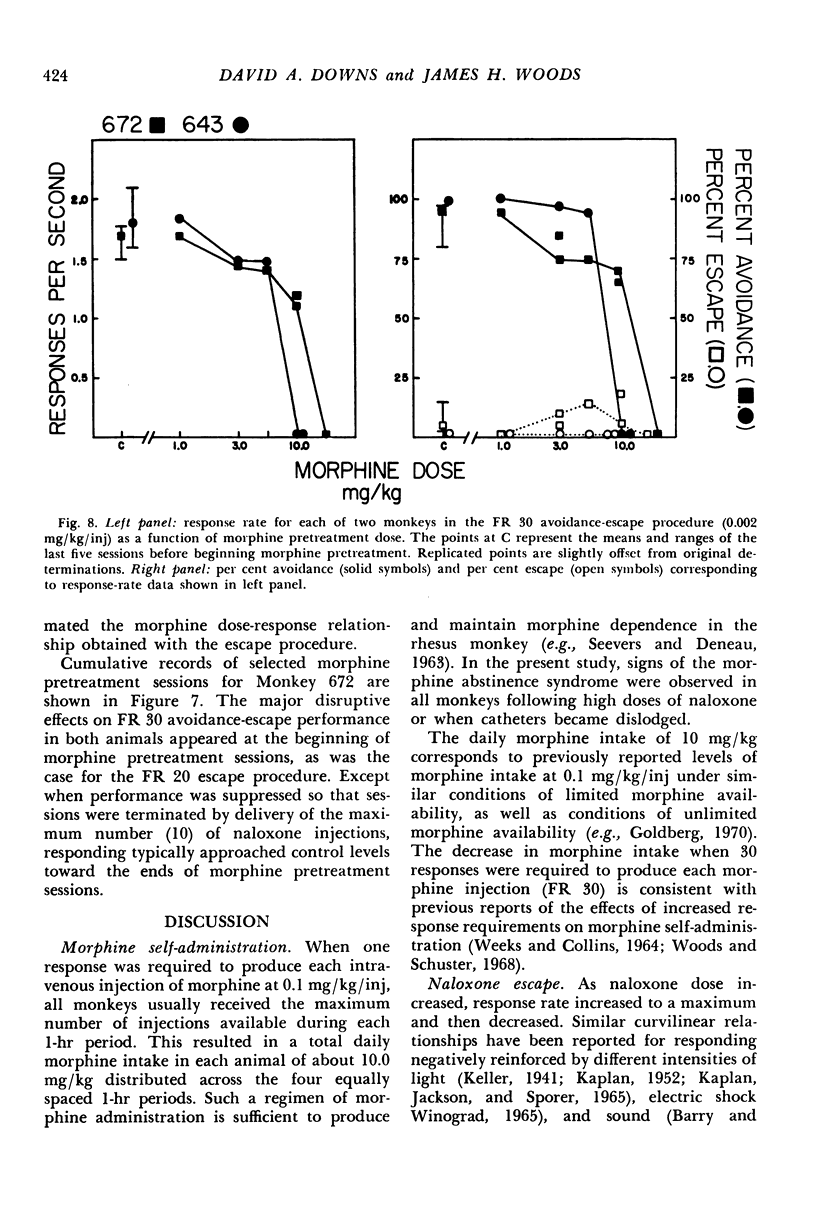


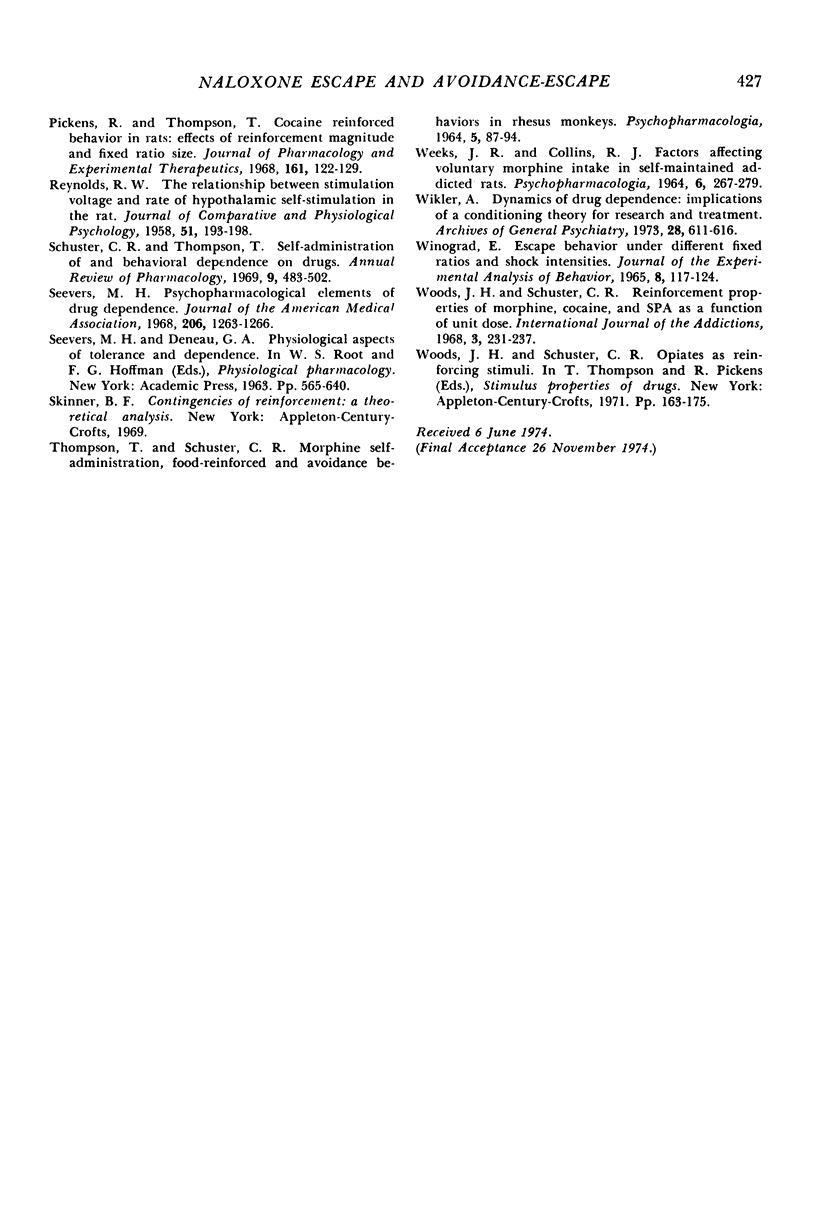
Selected References
These references are in PubMed. This may not be the complete list of references from this article.
- Balster R. L., Schuster C. R. Fixed-interval schedule of cocaine reinforcement: effect of dose and infusion duration. J Exp Anal Behav. 1973 Jul;20(1):119–129. doi: 10.1901/jeab.1973.20-119. [DOI] [PMC free article] [PubMed] [Google Scholar]
- Deneau G., Yanagita T., Seevers M. H. Self-administration of psychoactive substances by the monkey. Psychopharmacologia. 1969;16(1):30–48. doi: 10.1007/BF00405254. [DOI] [PubMed] [Google Scholar]
- Downs D. A., Woods J. H. Codeine- and cocaine-reinforced responding in rhesus monkeys: effects of dose on response rates under a fixed-ratio schedule. J Pharmacol Exp Ther. 1974 Oct;191(1):179–188. [PubMed] [Google Scholar]
- Goldberg S. R. Comparable behavior maintained under fixed-ratio and second-order schedules of food presentation, cocaine injection or d-amphetamine injection in the squirrel monkey. J Pharmacol Exp Ther. 1973 Jul;186(1):18–30. [PubMed] [Google Scholar]
- Goldberg S. R., Hoffmeister F., Schlichting U., Wuttke W. Aversive properties of nalorphine and naloxone in morphine-dependent rhesus monkeys. J Pharmacol Exp Ther. 1971 Nov;179(2):268–276. [PubMed] [Google Scholar]
- Hoffmeister F., Wuttke W. Negative reinforcing properties of morphine-antagonists in naive rhesus monkeys. Psychopharmacologia. 1973;33(3):247–258. doi: 10.1007/BF00423059. [DOI] [PubMed] [Google Scholar]
- KAPLAN M., JACKSON B., SPARER R. ESCAPE BEHAVIOR UNDER CONTINUOUS REINFORCEMENT AS A FUNCTION OF AVERSIVE LIGHT INTENSITY. J Exp Anal Behav. 1965 Sep;8:321–323. doi: 10.1901/jeab.1965.8-321. [DOI] [PMC free article] [PubMed] [Google Scholar]
- KAPLAN M. The effects of noxious stimulus intensity and duration during intermittent reinforcement of escape behavior. J Comp Physiol Psychol. 1952 Dec;45(6):538–549. doi: 10.1037/h0055989. [DOI] [PubMed] [Google Scholar]
- Pickens R., Thompson T. Cocaine-reinforced behavior in rats: effects of reinforcement magnitude and fixed-ratio size. J Pharmacol Exp Ther. 1968 May;161(1):122–129. [PubMed] [Google Scholar]
- REYNOLDS R. W. The relationship between stimulation voltage and rate of hypothalamic self-stimulation in the rat. J Comp Physiol Psychol. 1958 Apr;51(2):193–198. doi: 10.1037/h0048362. [DOI] [PubMed] [Google Scholar]
- Schuster C. R., Thompson T. Self administration of and behavioral dependence on drugs. Annu Rev Pharmacol. 1969;9:483–502. doi: 10.1146/annurev.pa.09.040169.002411. [DOI] [PubMed] [Google Scholar]
- Seevers M. H. Psychopharmacological elements of drug dependence. JAMA. 1968 Nov 4;206(6):1263–1266. [PubMed] [Google Scholar]
- THOMPSON T., SCHUSTER C. R. MORPHINE SELF-ADMINISTRATION, FOOD-REINFORCED, AND AVOIDANCE BEHAVIORS IN RHESUS MONKEYS. Psychopharmacologia. 1964 Jan 7;5:87–94. doi: 10.1007/BF00413045. [DOI] [PubMed] [Google Scholar]
- WINOGRAD E. ESCAPE BEHAVIOR UNDER DIFFERENT FIXED RATIOS AND SHOCK INTENSITIES. J Exp Anal Behav. 1965 Mar;8:117–124. doi: 10.1901/jeab.1965.8-117. [DOI] [PMC free article] [PubMed] [Google Scholar]
- Weeks J. R., Collins R. J. Factors affecting voluntary morphine intake in self-maintained addicted rats. Psychopharmacologia. 1964 Oct 14;6(4):267–279. doi: 10.1007/BF00413156. [DOI] [PubMed] [Google Scholar]
- Wikler A. Dynamics of drug dependence. Implications of a conditioning theory for research and treatment. Arch Gen Psychiatry. 1973 May;28(5):611–616. doi: 10.1001/archpsyc.1973.01750350005001. [DOI] [PubMed] [Google Scholar]


